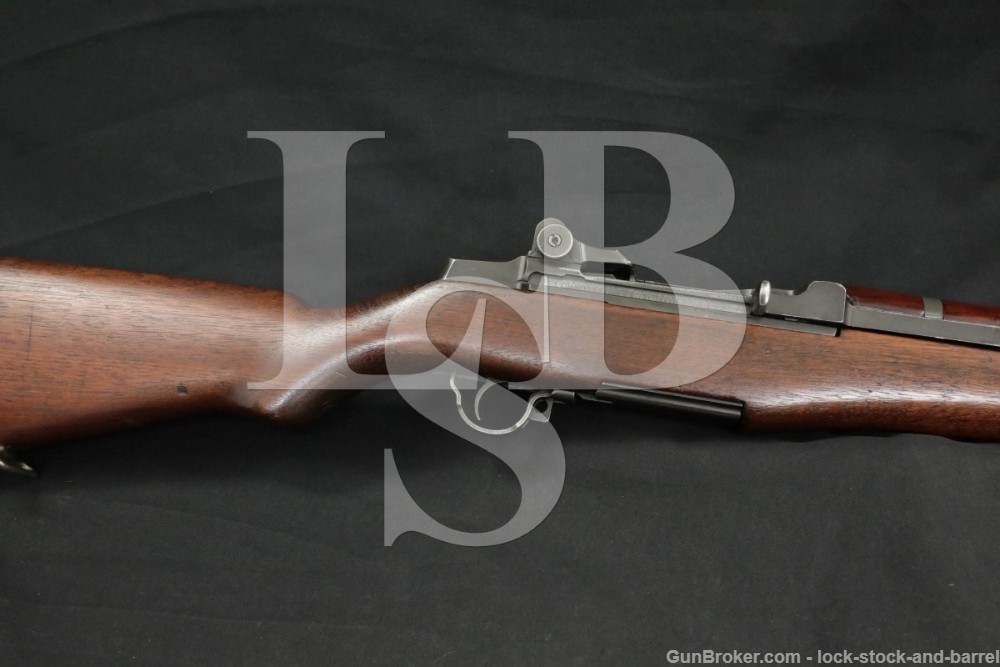
Harrington & Richardson M1 Garand H&R .30-06 Semi Automatic Rifle, 1954 C&R
SOLD FOR: $1475
LSB#: 211003NI04
Make: Harrington & Richardson (H&R) Arms Company
Model: M1 Garand. The rifle’s action uses all H&R parts. Most of the parts have markings or drawing numbers that correlate to the rifle’s serial number.
Serial Number: 5516157
Year of Manufacture: 1954 (page 30 of Joe Poyer’s M1 GARAND 1936 to 1957, 6th Edition). Barrel Date: 9-54
Caliber: .30-06 Springfield
Action Type: Semi Auto, En Bloc Clip Fed
Markings: There is no import mark. The gas cylinder lock screw is marked “HRA” which is a Harrington & Richardson part (page 115 of Joe Poyer’s M1 GARAND 1936 to 1957, 6th Edition).
Receiver: “U.S. RIFLE / CAL. .30 M1 / H. & R. ARMS CO. / 5516157”
Trigger Group: “6528290—HRA N”- Correct for the H&R serial number (page 90).
Hammer: “HRA 5546008”– Correct for the H&R serial number (page 99).
Safety: “HRA” – Correct for the H&R serial number (page 104).
Follower: unmarked – Correct for the H&R serial number (page 83).
Receiver Leg: “K” and “6528291” – Correct for a 1954 H&R M1 Garand (page 30).
Op Rod: “6535382 HRA” – Correct for the H&R serial number (page 71). The op rod shows signs of being rewelded and refinished.
Bolt: “6528287 HRA / .U.”- An H&R part (pages 51 & 52).
Barrel: “HRA 6535448 9-54 RS38”, “M”, “P”, and with a partial Defense “Eagle” acceptance stamp – An H&R part (page 62).
The stock and sights are described below.
Barrel Length: Approximately 24 Inches
Sights / Optics: The front sight is a blade set between two protective wings. The rear sight is a fully adjustable aperture sight set between two protective wings. The windage knob is marked “LEFT arrow” twice and “HRA-W”. The elevation knob is marked from “2-12” in increments of two and “HR A”. These are H&R rear sight markings (page 39-40).
Stock Configuration & Condition: The bottom of the grip is marked with faded “circled P” proof which is ovestamped by a partial upside down “boxed P”. The left side of the stock, above the trigger, is with a faded Defense “Eagle” acceptance stamp which is correct for an M1 stock made after Sept./Oct. 1953 (page 129-130).
The oil stained hardwood stock has a pistol grip, metal nosecaps, stacking loop, two sling loops, and a metal buttplate with hinged metal door for storage in the buttstock. The rear of the handguard shows a filled & repaired crack at the receiver. The stock shows several scrapes, scratches & compression marks. Many have damaged small portions of surface wood. These marks have been oiled. The LOP measures 13 inches from the front of the trigger to the back of the buttplate. The stock rates in about Very Good Plus overall condition as refurbished.
Type of Finish: Parkerized
Finish Originality: Refinished
Bore Condition: The bore is bright. The grooves near the muzzle are semi bright. The rifling is deep. There is fouling in the grooves near the muzzle. There is no erosion. The bore shows an M.E. of 0.7. The throat shows a T.E. of 2.
Overall Condition: This rifle retains about 96% of its metal finish as refinished. The op rod shows signs of being re-welded. The gas tube and trigger guard show scrapes and scratches. The metal shows scuffs, scrapes & light handling marks. The right side of the receiver and front of the bolt show light thinning consistent with cycling. The markings are deep. Overall, this rifle rates in about Very Good Plus to Fine condition as refinished.
Mechanics: The action functions correctly. We did not fire this rifle. As with all used firearms, a thorough cleaning may be necessary to meet your maintenance requirements.
Box, Paperwork & Accessories: None
Our Assessment:The M1 Garand had garnered a well-deserved reputation as the best standardized service rifle of WWII. At the end of WWII large numbers of Garands were in inventory and it was assumed they were sufficient to meet future military needs. That all changed when the Korean War broke out. Springfield Armory ramped up its Garand production line as quickly as possible, but additional sources were needed. International Harvester was contracted to produce M1 Garands in 1951. On April 3, 1952, H&R was given a contract for the production of M1 Garand rifles.
H&R had produced a number of types of firearms for the civilian market, but H&R’s prior experience in military firearm production for the government was primarily limited to the Reising .45 ACP submachine gun that it made during World War II. H&R was able to capitalize on its arms making experience during production and supplied International Harvester with assistance in producing M1 Garands. Unlike the mix of parts found on some IHC M1 Garands, there was typically much more consistency in the H&R rifles including the format of the receiver markings. Unlike IHC, H&R made its own barrels for most of the company’s production run. When International Harvester opted out of its contact, a number of the Line Material Corp. (LMR) barrels on hand were diverted to H&R and used to assemble some late-production rifles. LMR barrels are considered high quality barrels.
This Harrington & Richardson M1 Garand was made in 1954. The rifle has been refinished so it looks impressive. The rifle’s action uses all H&R parts. Most of these parts have markings or drawing numbers that match the rifle’s serial number. Even the gas cylinder lock screw and rear sights are marked “HRA”. This collectible M1 Garand has a strong bright bore. It will add to your Military collection and should do well at the range.

